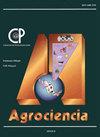DETERMINATION OF THE EFFECTIVE DOSE OF PHOSPHORUS IN LEMON EUCALYPTUS PLANTS (Corymbia citriodora)
IF 0.5
4区 农林科学
Q4 AGRICULTURE, MULTIDISCIPLINARY
引用次数: 0
Abstract
Phosphorus (P) is one of the most limiting nutrients for plant species and its intensive use can exhaust world reserves. In general, forest production is unviable without the availability of P. The objective of the study was to determine the effect of phosphate fertilization on plant growth of four families of lemon eucalyptus (Corymbia citriodora). Plants produced from seeds of four seed trees were used, which were subjected to seven doses of phosphorus: 0, 25, 50, 75, 100, 125 and 150 mg P dm-3. The experiment was carried out in a 7 × 4 factorial arrangement, with four replicates and using containers with 5 dm3 of a Red Eutropheric Latosol type soil. The response variables measured were monthly plant height, plant collar diameter at 90 d, dry biomass weight of leaves, roots, stems and branches, and phosphorus use efficiency of leaves. The variations of the characteristics evaluated as a function of phosphorus concentration were analysed by means of polynomial regression equations. Phosphate fertilization is necessary for the growth and development of C. citriodora plants. Plants of the four C. citriodora seed trees from different provenances responded differentially to phosphorus doses. It was found that the optimum amount of phosphorus ranges between 30 and 100 mg dm-3 according to the characteristics evaluated and the seed tree.柠檬桉(Corymbia citriodora)中磷有效剂量的测定
磷(P)是植物最具限制性的营养物质之一,它的大量利用会耗尽世界储量。一般来说,没有磷的供应,森林生产是不可行的。本研究的目的是确定磷肥对柠檬桉(Corymbia citriodora)四个科植物生长的影响。采用四种种子树种子生产的植株,分别施用0、25、50、75、100、125和150 mg pdm -3七种剂量的磷。试验采用7 × 4因子设计,4个重复,采用5 dm3的红壤型富营养化土壤。测定的响应变量为月株高、90 d时株颈直径、叶、根、茎、枝干生物量和叶片磷利用效率。利用多项式回归方程分析了磷浓度对特征变化的影响。磷肥是香茅植物生长发育所必需的。不同种源的四种柑橘种子树的植株对磷剂量的响应存在差异。根据评价结果和种子树的特点,发现磷的适宜用量为30 ~ 100 mg dm-3。
本文章由计算机程序翻译,如有差异,请以英文原文为准。
求助全文
约1分钟内获得全文
求助全文
来源期刊

Agrociencia
农林科学-农业综合
CiteScore
0.50
自引率
33.30%
发文量
51
审稿时长
18-36 weeks
期刊介绍:
AGROCIENCIA is a scientific journal created and sponsored by the Colegio de Postgraduados. Its main objective is the publication and diffusion of agricultural, animal and forestry sciences research results from mexican and foreign scientists. All contributions are peer reviewed. Starting in the year 2000, AGROCIENCIA became a bimonthly and fully bilingual journal (Spanish and English versions in the same issue). Since 2007 appears every month and a half (eight issues per year). In addition to the printed issues, the full content is available in electronic format.
 求助内容:
求助内容: 应助结果提醒方式:
应助结果提醒方式:


